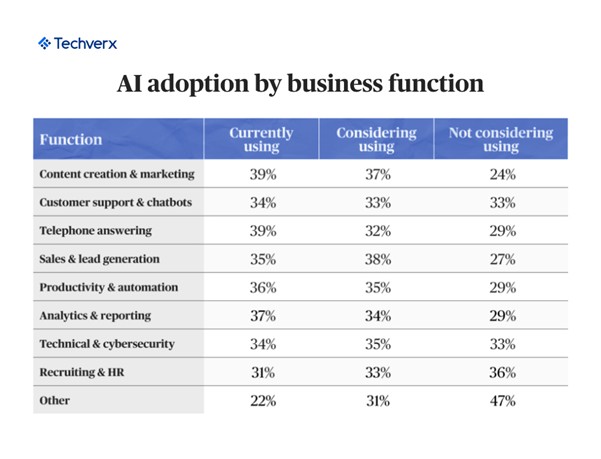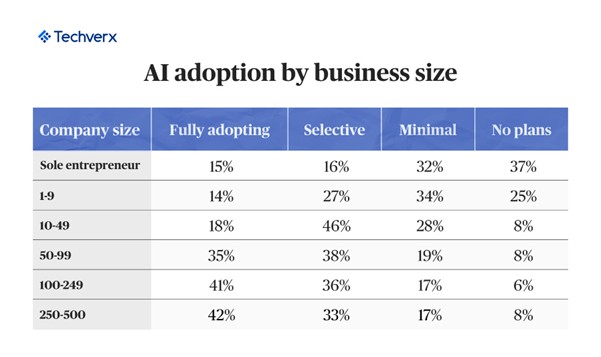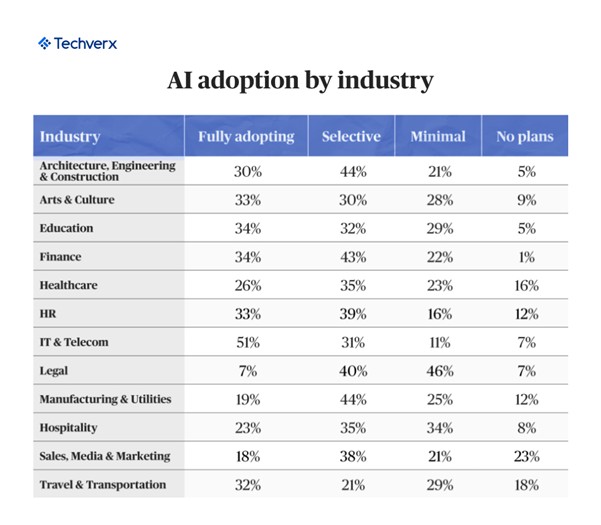
AI Adoption Under Pressure: How North American Enterprises Are Building Strong Foundations

The State of AI Adoption in U.S. Businesses
We often hear about artificial intelligence discussed in sweeping terms, breakthrough innovations, bold forecasts, and its transformative potential for the future. But what does AI adoption look like within day-to-day operations of U.S. businesses right now?
To answer this, A company in the US conducted a survey with 750 decision-makers across U.S.-based businesses between April and May 2025. The purpose was clear: to learn how businesses are engaging with AI today, pinpoint where it is driving measurable impact, and determine what stage they are at in their AI adoption journey.
The results reveal a compelling picture of where AI adoption stands today, where it appears to be heading, and what this means for businesses of all sizes.

Are U.S. businesses currently using AI?
A pie chart illustrates the levels of AI engagement across U.S. companies. The findings show that 34% of businesses are already using AI in some capacity. A nearly identical 34.27% report that they are actively considering adoption. Taken together, this means that approximately two-thirds 68% of businesses are either currently deploying AI or have plans to begin doing so.
Meanwhile, 32% of businesses indicate that they are not considering AI at all at this point.
This relatively even distribution between adopters, those intending to adopt, and holdouts suggests that the market is still in the process of finding its footing. There is strong interest in AI, but many companies are still wrestling with practical questions about its costs, its value, and where exactly it fits within their operations. As adoption accelerates, the conversation is shifting away from whether businesses will use AI toward how and where they can deploy it to achieve the greatest effect.
How are businesses adopting AI?
Respondents were asked to indicate where they currently are on their AI journey, and their responses reflect a spectrum of approaches.

Just over one-quarter (27%) report that they are fully embracing AI across their businesses. These represent the early movers, companies that typically have the resources, expertise, or executive leadership to implement AI at scale.
For the majority, however, adoption is more selective. About 33% report that they are using AI in specific functions while continuing to evaluate additional areas where it could create value.
Another 25% remain in the early phases, using AI only in limited ways at present. Finally, 15% report that they have no plans to adopt AI at all.
This mix of responses demonstrates that while some organizations are charging ahead, most are taking a careful, step-by-step approach. Rather than jumping headfirst into full automation, they are prioritizing AI implementations that complement and support their teams. This incremental method allows businesses to learn from real-world usage, refine their strategies, and scale adoption in a way that feels sustainable. For many, this is proving to be the smartest strategy moving forward.
The top areas AI is being used by businesses today
Although AI is still seen by many as an emerging technology, U.S. businesses are already using it across a range of practical, everyday applications.

Enter Staff Augmentation: Your Strategic Accelerator
Leading the way is content creation and marketing, where 39% of businesses are leveraging AI tools. Matching it closely, 39% are using AI for telephone answering, highlighting just how quickly AI has become embedded in customer-facing operations.
Analytics and reporting functions follow at 37%, with productivity and automation tools at 36%, and technical support and cybersecurity at 34%. These are areas where AI clearly helps teams work faster, more intelligently, and with fewer bottlenecks.
The fact that so many of these functions are close in adoption percentage, most sitting in the 33–39% range, suggests that companies are not just experimenting with AI in a single area but are applying it to multiple processes to unlock immediate benefits.
Telephone answering, in particular, is worth keeping an eye on. One in three businesses already use AI to assist with call handling, and another third are actively evaluating it. In sectors that deal with high call volumes, such as professional services and real estate, adoption could rise rapidly.
Overall, the dominant trend is clear: the most successful use cases are those that enhance human capabilities rather than replace them. Whether it’s helping teams respond faster, take over repetitive work, or produce content at scale, AI is emerging as a valuable teammate rather than a takeover threat.
Company size matters but it’s not everything
It comes as little surprise that larger businesses are generally at the forefront of AI adoption. But the data provides a more nuanced perspective.

ERP Data Migration: The Hidden Cost Driver
Among solo entrepreneurs, just 15% report that they have fully embraced AI, while over 37% say they are not considering it at all. This means that more than half of the smallest U.S. businesses remain on the sidelines, often constrained by limited bandwidth, lack of confidence, or simply competing priorities.
Businesses employing 50–99 people tell a different story. In this group, only 8% say they have no plans to adopt AI, while more than one-third 35% have already implemented it across their organizations. This mid-sized segment seems to be in the “sweet spot,” with enough internal capacity to implement new tools but still agile enough to pivot quickly when the right solutions present themselves.
At the upper end, large companies with 250–500 employees are setting the benchmark for full adoption, with 42% reporting that they have gone all-in on AI. Thanks to their budgets, staffing resources, and organizational structures, these companies can experiment, refine, and scale AI initiatives much more readily.
The key takeaway is that while company size can influence adoption rates, the more critical factors are access to time, resources, technology, and confidence. As AI tools become easier to use and more tailored to specific industries, the adoption gap is likely to narrow. This will be especially true in functions like marketing, automation, and reporting, where even small implementations can produce significant benefits.
How Staff Augmentation Can Unlock AI Adoption
One of the biggest challenges companies face when rolling out AI is securing the right expertise quickly enough to act on opportunities. Many internal teams are already stretched thin, and AI initiatives require skills, data engineering, machine learning deployment, cloud infrastructure management, that may not exist in-house.
Staff augmentation offers a solution by giving companies immediate access to on-demand, vetted specialists who can jump in where they are needed most. Whether a business needs to stand up a proof-of-concept, migrate workloads to the cloud, or integrate AI-driven analytics into existing systems, augmented teams can make it happen without the cost and delay of hiring full-time staff.
This approach is particularly effective for the 33% of businesses that are selectively adopting AI in specific areas or the 25% still running limited pilots. By augmenting their teams, they can accelerate implementation, test and refine use cases in real time, and scale what works, turning isolated experiments into measurable business outcomes.
Even for larger enterprises with internal AI teams, staff augmentation acts as a force multiplier. It allows them to bring in niche expertise for high-value initiatives, reduce bottlenecks, and speed up deployment schedules without losing momentum.
In short, staff augmentation levels the playing field. It transforms AI from a daunting, resource-heavy initiative into an achievable, scalable advantage, making it possible for businesses of any size to move from cautious exploration to confident, enterprise-wide adoption.
Ready to take the next step? Partnering with a team that understands AI adoption and can integrate seamlessly with your processes can help you get there faster. Whether you’re exploring your first AI use case or scaling to full adoption, staff augmentation ensures you have the right talent at the right time to turn strategy into impact.
Industry-by-Industry: Who’s Leading the Way?
When we look at both businesses that have fully embraced AI and those adopting it selectively, we get a much clearer picture of which sectors are ahead of the curve, even if they haven’t rolled it out universally across every team just yet.

According to the data, Tech & Telecom takes the top spot, with more than 80% of businesses in this category either fully embracing AI (51%) or selectively using it (31%). This finding isn’t surprising for an industry built around innovation, where teams are often well-prepared to experiment with new technology, integrate it into workflows, and scale solutions rapidly.
Finance, with 77% of businesses either fully or selectively adopting AI, shows similar momentum. Human Resources (72%) and Architecture, Engineering & Construction (74%) are also demonstrating strong engagement with AI tools and strategies. These are sectors where structured processes, heavy reliance on data, and operational efficiency play a major role, making them well-suited for AI’s strengths in process automation and insight generation.
On the other hand, adoption looks more measured in industries like healthcare (61%), Education (66%), and Arts & Culture (63%). These are fields where human interaction is central, and automation often rolls out cautiously to avoid disrupting critical personal relationships. In these spaces, trust, ethical considerations, and human impact take priority, which naturally slows the pace of adoption.
Legal services stand out as one of the slowest adopters of AI. Just 7% of businesses in this sector report fully embracing AI, with nearly half (46%) saying they use it only minimally and another 7% not considering it at all. The slower adoption rate could be attributed to stringent regulatory requirements, risk sensitivity, and the complexity of legal workflows, which often makes implementing automation more challenging.
Sales, Media & Marketing, and Travel & Transportation are also showing higher levels of hesitation. These industries may have less straightforward paths to adoption, but the potential remains strong, especially as AI tools continue to become more tailored to customer experience and front-line operations.
What’s clear is that every industry is charting its own unique course when it comes to AI adoption. As AI technologies mature and become more specialized, even those industries that are cautious today may see significant momentum in the near future.
Regional Leaders in AI Adoption
AI adoption isn’t influenced only by industry, it’s also shaped by geography. Where a business is located can play a major role in how quickly it adopts new technologies.

Survey data highlights some clear regional frontrunners. Businesses in the Mountain region lead the nation, with 42% fully embracing AI, the highest rate in the country. This likely reflects a growing number of innovation hubs, relatively lower operating costs, and the ability of companies in these areas to serve national markets from flexible, tech-friendly bases.
East North Central states, including Illinois, Ohio, and Michigan, are not far behind, with 37% of businesses in the region reporting full AI adoption. This is a part of the country where manufacturing, logistics, and other process-heavy industries are prominent, which explains why AI is increasingly being used to modernize and streamline traditional operations.
The Mid-Atlantic region, covering New York, New Jersey, and Pennsylvania, is also performing above the national average. Nearly a third (30%) of businesses here have fully embraced AI, while another third (36%) are using it selectively.
By contrast, the West North Central states, such as Iowa, Nebraska, and the Dakotas, are seeing slower adoption, with only 8% reporting full AI usage. This region also reports the highest combined rate of minimal usage and non-adoption, at more than 60%. This lag may be influenced by a concentration of traditional industries and smaller average business sizes, which often limits investment in emerging technology.
Elsewhere, businesses in the South Atlantic and Pacific regions appear to be taking a more cautious approach. Adoption is more selective in these areas, with many organizations still exploring options and testing AI tools in limited ways.
The overarching insight is that AI adoption is not just a matter of what your business does, but where it operates. Local ecosystems, availability of skilled talent, and access to knowledge all shape the pace of adoption. For businesses located in slower-moving regions, this represents a unique opportunity to become a local leader, even if the national average is still catching up.
What This Means for U.S. Businesses
The trends in both industry and geography point to a clear direction of travel for AI adoption. The shift is moving from isolated experiments to more strategic and coordinated efforts. Many businesses are beginning to develop formal AI roadmaps, assign internal champions, and set clear objectives for what success should look like.
The next wave of AI growth is likely to focus heavily on tools designed specifically for small and mid-sized businesses. As solutions become more intuitive and industry-focused, these organizations will be able to adopt AI faster and with less technical friction. This will pave the way for more “plug-and-play” solutions that solve real-world challenges—not just tools designed for highly technical teams.
Crucially, businesses are learning that the most effective approach is not to replace human teams but to partner AI with human decision-making. The future points to hybrid models where chatbots provide first-line support but hand off to people when needed, where automation takes over repetitive work, and where insights empower human teams to work smarter.
At the same time, transparency and ethics will grow in importance as AI becomes a more visible part of customer experiences. Businesses will need to clearly communicate how AI is being used, ensure it aligns with their values, and maintain trust with customers.
Finally, training and upskilling will be key drivers of success. Teams need more than access to tools, they need the confidence and know-how to use them effectively. This will require investment in learning, cross-team collaboration, and initiatives to demystify AI within the organization.
The overarching message is simple: start where the impact will be most immediate, scale what works, and keep people at the heart of every initiative. The businesses that succeed with AI will be those that balance innovation with empathy, using technology to amplify, not replace, the value created by their teams.
Staff Augmentation: Turning AI Goals Into Reality
Even for organizations that are ready to act, the biggest barrier is often execution, finding the right people with the right skills to make AI adoption a reality. Building in-house teams takes time, which can slow momentum and stall competitive advantage.
This is where Techverx comes in. Through our staff augmentation services, we help businesses at every stage of their AI journey access the exact talent they need, data engineers, ML specialists, cloud architects, QA experts, without the overhead of full-time hiring. Whether you’re running small pilots, selectively adopting AI in certain areas, or aiming to scale adoption enterprise-wide, Techverx provides the expertise and integration to move faster.
Our approach ensures that AI implementation supports your people, not overwhelms them. We embed our teams into your processes, deliver measurable outcomes, and transfer knowledge along the way, so your internal teams grow stronger while adoption accelerates.
For businesses in industries or regions lagging, this is your opportunity to leapfrog competitors. And for those already leading, staff augmentation helps you scale faster, experiment more, and keep innovation moving without burning out your core teams.
Ready to explore what’s possible? Talk to Techverx about how our staff augmentation services can help you unlock the full potential of AI, on your terms, at your pace, and with the right people by your side.
Hiring engineers?
Reduce hiring costs by up to 70% and shorten your recruitment cycle from 40–50 days with Techverx’s team augmentation services.
Related blogs


